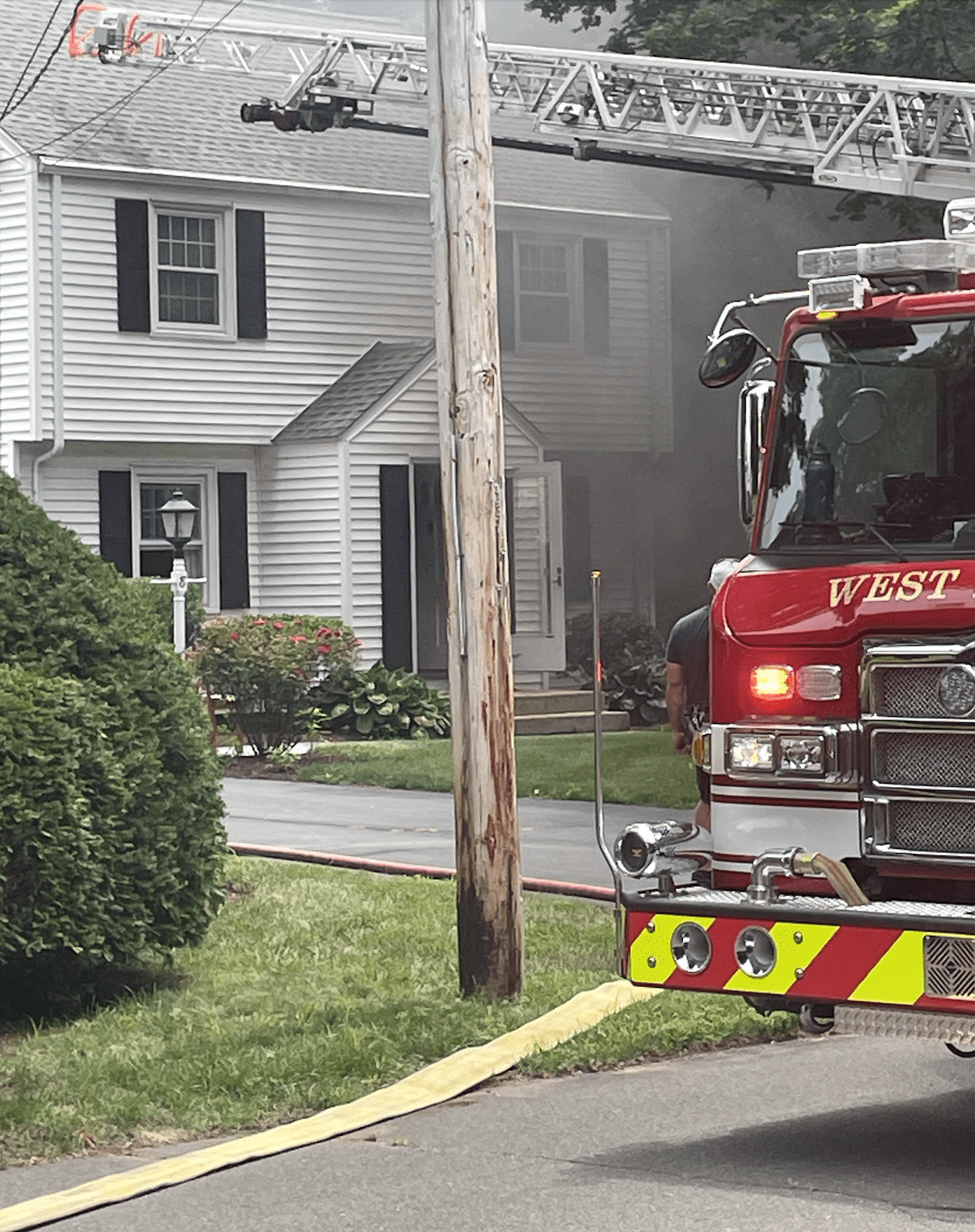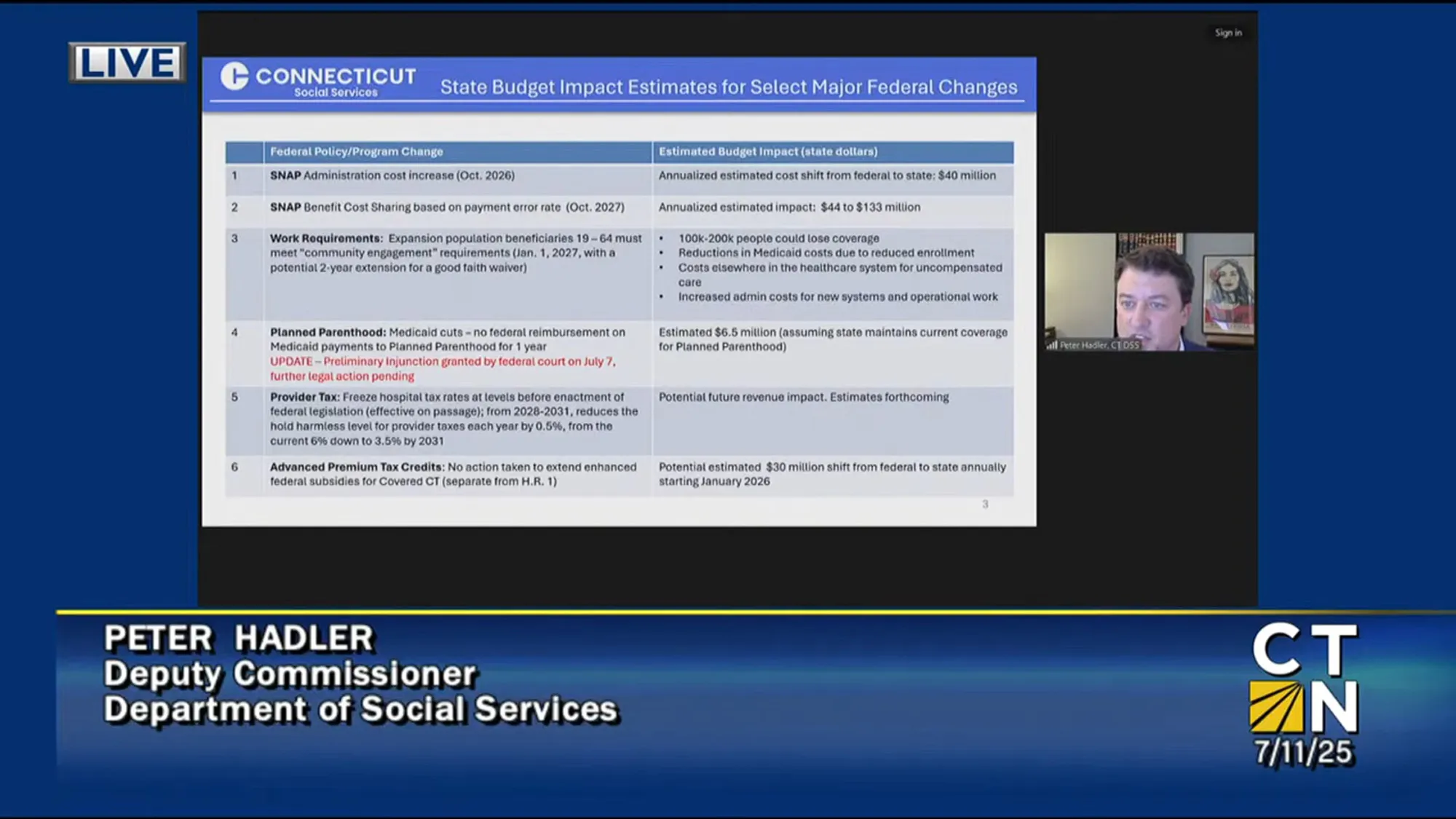Easing of Restrictions May Expand Competition for West Hartford High School Athletes

Audio By Carbonatix

Conard's Harrison Sweeney tries to block a Hall/Southington shot. Hall/Southington hockey. Feb. 15, 2021. Photo credit: Paul Palmer (we-ha.com file photo)
West Hartford’s athletic director said the easing of restrictions may provide some additional opportunities for winter sports athletes, and he is optimistic about what it will mean for spring competition.
By Ronni Newton
Restrictions on youth sports are easing in March, and the National Federation of State High School Associations (NFHS) has eliminated classifications of sports by risk level, but exactly how that will impact the rest of the winter season for West Hartford’s high school athletes remains to be seen.
Winter sports such as cheerleading and wrestling had previously been declared as “high risk,” and when the winter sports season was allowed to resume on Jan. 19, the Connecticut Interscholastic Athletic Association (CIAC) had limited participation in those sports to just conditioning and non-contact skills training.
Risk classifications were dropped at the beginning of February.
In addition, while indoor track athletes were permitted to practice when the winter season began, meets – which generally involve dozens of teams in large venues – were put off until at least the beginning of March.
“Following recently revised guidance from the National Federation of State High School Associations (NFHS), the CIAC met with representatives from the Connecticut Department of Public Health and Governor Lamont’s office to discuss how those revisions may impact interscholastic athletics,” the CIAC said in a statement Feb. 18.
For the purposes of high school athletics, the CIAC had formally requested the state’s Department of Public Health (DPH) to revisit competitive cheerleading and dance and wrestling – which had been classified as high risk, as well as indoor track jumping events. They also asked DPH for guidance on boys lacrosse, a spring sport that had been classified as high risk.
Competitive cheerleading and dance
DPH Acting Commissioner Deidre Gifford, in a Feb. 15, 2021 letter to CIAC Executive Director Glenn Lungarini that was provided to We-Ha.com, said that competitive cheerleading and dance will be allowed to take place with “full team practices and virtual competitions,” noting that the sports are similar to other sports that are being permitted to operate. Masks are required at all times, except that they may be removed briefly only while individuals are actively engaged in “stunts, lifts, tumbling, and other acrobatics.”
The CIAC plans to permit competitive cheerleading and dance to take place in accordance with DPH recommendations and the following of COVID-19 protocols and mitigation strategies, with virtual competition allowed after March 1.
West Hartford Athletic Director Jason Siegal said that Hall High School currently has a small number of cheerleaders who have been taking part in conditioning workouts, virtually and in small groups. He wasn’t yet sure if they would be ready to participate in any competitions, but planned to discuss it with coaches and review additional information expected from the CIAC this week.
“Without having engaged in strenuous activities, I’m nervous about getting into something,” Siegal said, noting that he wants to avoid the chance of injury.
Wrestling
DPH did not sanction wrestling, noting that “close contact between individuals is unavoidable and mask use [while wrestling] has been deemed unsafe” by the American Academy of Pediatrics (AAP).
“Although 15 minutes has been used as a temporal benchmark for considering whether an individual should be considered a close contact of a known case, this timing assumes normal interaction at a relative resting state. In the case of intense, face-to-face, unprotected contact between individuals (for example when exposed to a cough or sneeze), CDC recommends that the time criteria should be discounted, and close contact should be assumed at any duration. While mask use may provide some level of protection against respiratory droplet exchange during active wrestling, AAP guidance specifically lists wrestling as a sport where mask wearing is not recommended due to potential safety risks,” Gifford’s letter stated.
The CIAC stated that in accordance with DPH guidelines, wrestling teams may continue to engage in conditioning and non-contact skill building only.
At Conard and Hall, “wrestling is going to remain as is, with non-contact, skill-building, and conditioning activities,” Siegal said.
Both schools have students participating in wrestling programs, and they have been practicing three to five times a week. “It’s been working out really well,” Siegal said.
Indoor track
DPH said that indoor track athletes will be permitted to remove their masks briefly during their approach and while jumping, but must put them back on after the jump has been completed.
The CIAC’s Board of Control voted to allow schools to begin holding indoor track dual meets as of March 1, with masks required at all times during running events, and jumpers allowed to remove their masks briefly as recommended by DPH.
But although indoor track and field athletes at Conard and Hall have continued to practice, the possibility of competing during this winter season remains slim.
“I just don’t see how that’s going to happen facility-wise,” Siegal said.
Most of the indoor track meets in Connecticut involve dozens of teams and hundreds of athletes and are held at the Floyd Little Athletic Center in New Haven, but that facility was turned into a mass COVID-19 vaccination site in late January. There are few other sites in the state that have an indoor track and would possibly be able to schedule dual meets for high school teams.
“Our coaches and kids have been meeting regularly and doing what we can do with the limited space we do have,” Siegal said, using the auxiliary gyms at both high schools. They’ve even been practicing jumping, and until now have been wearing masks the entire time, and also bringing their own individual tarps to land on.
Lacrosse, and other spring sports
DPH confirmed receipt of the CIAC’s request to consider boys lacrosse to be a similar risk to girls lacrosse, soccer, and field hockey, but said they have not considered recommendations yet for spring sports.
“To the extent boys games can be officiated in such a way as to reduce the frequency, duration, and intensity of contact among participants, the risk with this sport can be reduced,” Gifford said in her letter. She noted there may be ways to diminish risk such as modifying or eliminating the “face-off” component of the game, which necessitates close contact.
Winter sports seasons conclude on March 28, and spring sports are permitted to begin practice as early as March 27, with contests beginning on or after April 10, the CIAC said.
State tournaments are currently planned, and will be held between June 1-13. The final regular season games/meets that will count as qualification for the state tournament will be May 27.
“The CIAC is in the process of developing COVID mitigating plans for all spring sports,” the organization said last week.
Siegal is hopeful that boys lacrosse, a popular sport in West Hartford, will be able to take place this spring now that the risk categorization of sports has been eliminated.
“It’s trending in a more positive direction for boys lacrosse,” he said.
Spectators
Although restrictions have been modified to allow spectators at youth sporting events (25% of capacity, up to 200 people maximum), the CIAC last week reaffirmed its position that fans/spectators should not be permitted to attend high school winter sports events. The organization has, however, allowed the school districts to make their own decisions.
In West Hartford, home teams are allowed two spectators per athlete for both girls and boys basketball and ice hockey events. Unlike during fall outdoor sports competition, where both Conard and Hall athletes were permitted two guests when the teams played each other, in the winter only the actual “home team” is permitted to have spectators.
Spectators are not permitted at Cornerstone Aquatics Center for boys swimming and diving, nor are they permitted for gymnastics meets at Whiting Lane – other than the parents of the two seniors who were allowed to attend Monday’s senior night meet.
Most Conard and Hall home sporting events are streamed live by West Hartford Community Interactive, and can also be viewed on the station’s YouTube channel.
Siegal said he doesn’t know what the spectator rule will be for spring sports, and he will continue to have discussions with the school principals.
Neither Conard nor Hall has had a team forced to quarantine yet this winter season, Siegal said, although a few of their opponents have had to suspend play leading to changes in the schedule.
Like what you see here? Click here to subscribe to We-Ha’s newsletter so you’ll always be in the know about what’s happening in West Hartford! Click the blue button below to become a supporter of We-Ha.com and our efforts to continue producing quality journalism.



